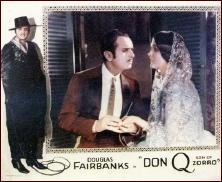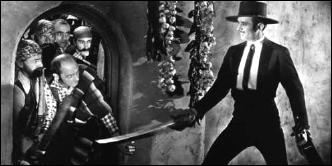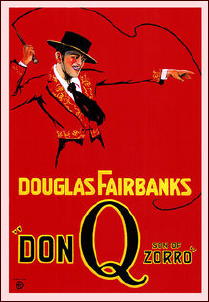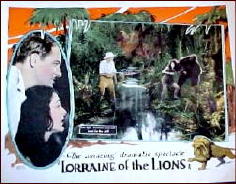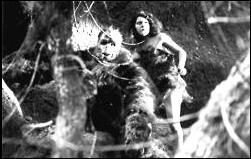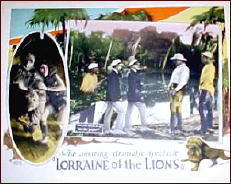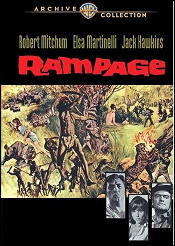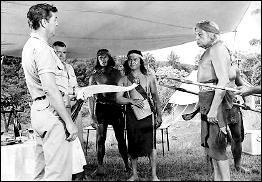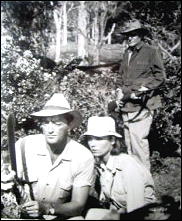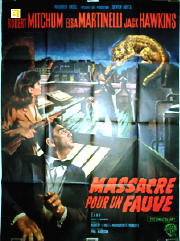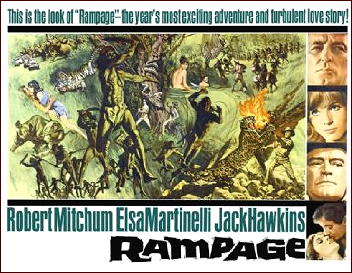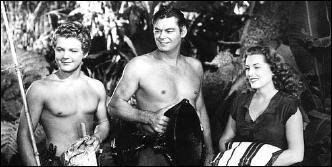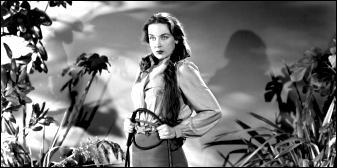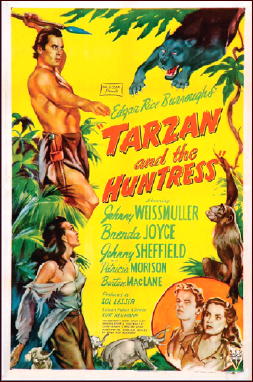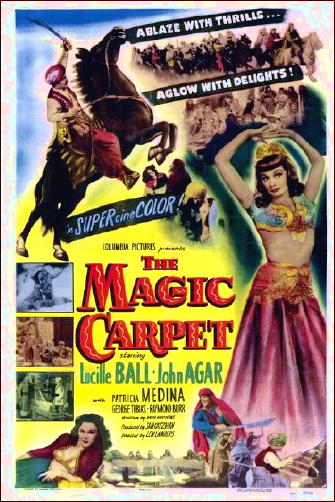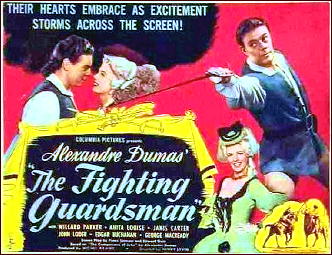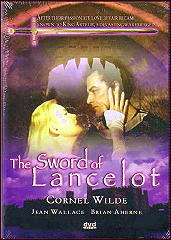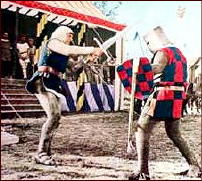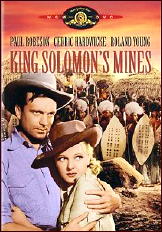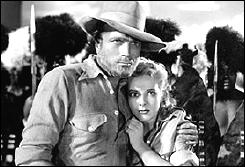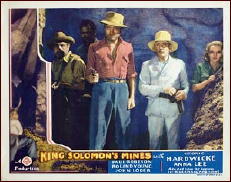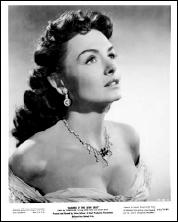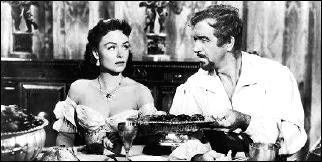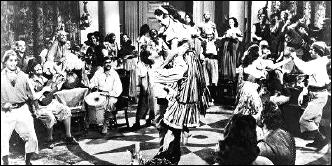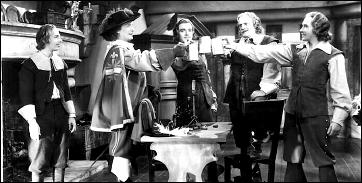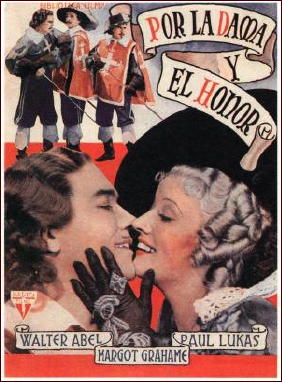Reviewed by DAVID L. VINEYARD:
THE MAGIC CARPET. Columbia Pictures, 1951. Lucille Ball, John Agar, Patricia Medina, Raymond Burr, Gregory Gaye, George Tobias, Rick Vallin. Directed by Lew Landers.

“You would be caliph, I a queen. Why not caliph and queen together?”
Lucille Ball had to be gnashing at the bit in this low budget Arabian Nights fare with John Agar’s flat Midwestern monotone marking him as the most unlikely Arabian swashbuckler since Oklahoma cowboy Dale Robertson and Paul Henreid.
Ball’s career had begun as a chorus girl at MGM (if you look quickly you can spot her wearing little but long blonde hair in an early Eddie Cantor outing Roman Scandals), with a long but steady climb up to stardom marked by mostly minor films with a few good roles in major fare like Stage Door (with Katherine Hepburn and Ginger Rogers), a brief period of popularity in films like Du Barry Was A Lady, The Big Street, and Easy To Wed (in the Jean Harlow role from Libeled Lady), and even credit for discovering one of MGM’s greatest stars — Van Johnson.
Even after leaving MGM for RKO she enjoyed some success, and just one year before this had scored well with Bob Hope in Fancy Pants, a technicolor remake of Ruggles of Redgap.
But in 1951 she was limited to doing films like Magic Carpet with leads like John Agar — a long fall from the likes of William Holden, Gene Kelly, and co-starring with Spencer Tracy and Katherine Hepburn (Without Love) and films like The Dark Corner, Lured, Miss Grant Takes Richmond, and Sorrowful Jones.
Luckily for her she had options. My Favorite Husband, her long running hit radio series with Richard Denning was being considered for television, and she and Cuban band leader husband Desi Arnaz had plans for that medium …
The Magic Carpet is Arabian Nights by rote. The Caliph is over thrown by evil Ali (Gabriel Gaye) and his henchman Boreg al Buzzar (Raymond Burr), who murder the Caliph and his wife, but not before she places their infant son on the magic carpet of the title, which carries him to safety and the sanctuary of a local physician, her uncle.

The true Caliph grows up to be Dr. Ramoth (John Agar), who is also the bandit leader, the Scarlet Falcon, bane of the Caliph Ali and his Grand Vizer Boreg and their corrupt reign.
In something of a twist, Lucille Ball is not the heroine of the film. That doubtful honor goes to Patricia Medina, who was virtually a staple in this sort of thing — and has here one of the worst dance numbers in the history of Arabian Nights nonsense. Lucy is Princess Narah, the evil Ali’s willful and sexually predatory sister, while Medina is Lida, the sister of Razi (George Tobias — and you have to wonder at the genetics that produced those progeny), the Scarlet Falcon’s right hand man.
Meanwhile Dr. Ramoth inveigles his way into the royal palace as court physician where he is a great hit with Narah and the Harem, and when his uncle is murdered by suspicious Boreg learns of his own royal birth and the magic carpet, excuse for some terrible special effects and mediocre mat paintings.
I’d like to say Lucy does her best as the semi evil Narah, but frankly both she and Medina play their respective roles like a pair of feuding strippers with Lucy’s attempts to seduce poor wooden Agar almost as funny as some of her routines on I Love Lucy, if not intentionally.
Substitute a G-string and pasties for their Arabian finery and move the plot backstage at a burlesque theater and you’d never notice the difference. If this film was any flatter, it wouldn’t even be in two dimensions.
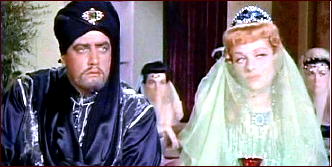
These things depend on the good will of the audience and the ability of the actors to make us want to believe in the silly but colorful goings on. In the hands of a Cornell Wilde, Jon Hall, or Jeff Chandler and a leading lady like Maria Montez, Maureen O’Hara, Rhonda Fleming, or even the unlikely Virginia Mayo the whole nonsensical thing can be great fun. Here no one seems even willing to try. It doesn’t even rise to the level of cynical exploitation.
Lucille Ball didn’t make another film until The Long Long Trailer in 1953, an attempt to cash in on the success of I Love Lucy. She did a few films in later years, notably with Bob Hope and Henry Fonda, and bowing out from film finally with the hideous film version of the Broadway musical Mame.
Her legendary television career and the success of Desilu studios more than made up for it, but you have to think she would have preferred to go out of her big screen career on a better note.
I’m usually forgiving of these, and even will admit to a taste for the better ones, but this has worse production values than an episode of I Dream of Jeanie, and performances that would have to be upgraded to reach the level of a burlesque comedy routine.
Still, Raymond Burr at his heaviest and wielding a scimitar is a sight you don’t often see (“This time Doctor, you must tend to a man and not on the ladies of the Harem!”), and the fact that Lucy was pregnant might somewhat mitigate her flat performance — this script would have been enough to give anyone morning sickness:
Narah: You would not put a princess in the dungeon?
Ramoth: I wouldn’t if she were a princess.
Ramoth regains his throne, Lucy and the evil Ali get their comeuppance, and Ramoth and Lida get a final clench on the magic carpet:
Lida: How long I’ve waited for this.
Ramoth: It’s not easy to embrace a tigress.
Lida: From now on you see a lamb.
Ah, well, it could be worse. Though I’m not exactly sure how.
Editorial Comment: The whole movie appears to be available on YouTube. This link will take you to some excerpts, so that you may get an overall impression of the film, should you care to continue.
